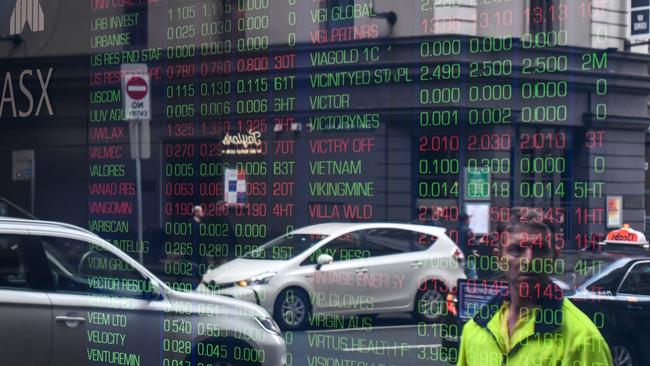So far, so good for reporting season
It’s early in the August reporting period for corporate Australia, but so far, it’s no disaster.

It’s early in the August reporting period for corporate Australia, but so far it’s no disaster.
With 14 of the top 200 companies — including heavyweights such as Commonwealth Bank, Telstra and Transurban — out in the past two days, earnings season was about 20 per cent of the way through by number. But even after a modest pullback on Thursday, the stockmarket is only about 2 per cent away from six-month highs after bouncing as much as 40 per cent from an eight-year low of 4402.5 in March.
After hitting a two-month high of 6186.1 on Tuesday, the S&P/ASX 200 index hit a three-day low of 6075.80 on Thursday before closing down 0.7 per cent at 6091, with heavyweight stocks including CBA, Telstra and CSL accounting for most of the fall.
For the best part of five months, the local market has been pulled higher by global fiscal and monetary stimulus, with the second wave of coronavirus on the east coast of Australia and fresh mobility restrictions in Victoria causing only moderate underperformance, as US markets neared record highs amid improving coronavirus trends, as well as vaccine hopes and the prospect of another round of fiscal stimulus, even if negotiations are stalled in congress.
Earnings per share forecasts bottomed about three months after the ASX 200 bottomed in March, and the consensus estimate has basically followed the index higher as usual.
But, as JPMorgan strategists have observed, the current 12-month forward price-earnings multiple above 20 times implies a 20 per cent bounce in earnings, negative interest rates or a combination of both.
Still there seems no reason the Australian earnings season can’t turn out like the recently concluded US earnings period, when most companies beat admittedly low-bar expectations, and certainly didn’t hinder the gains on Wall Street in recent weeks.
Of course there’s plenty of time for the earnings season to turn sour. Traders will recall the August 2019 reporting season, which got worse as it went along.
But it didn’t matter anyway because the Fed saved the day with back-to-back rate cuts in September and October and the Reserve Bank also cut rates in October.
There have been major disappointments, to be sure. Telstra dived 8 per cent after its 2020-21 earnings guidance missed the consensus estimate by about that amount, and AGL Energy fell 9.6 per cent after it forecast a “material decline” in its underlying profit for the same period.
Transurban lost 2.3 per cent and CBA fell 2.6 per cent after their 2019-20 profits missed estimates a day earlier, albeit with strong balance sheet settings in the case of CBA. Bell Potter’s TS Lim cut CBA to “hold” after trimming his profit forecasts due to lower non-interest income estimates, but left his price target unchanged at $78 because of the bank’s strong balance sheet.
UBS’s Jonathan Mott raised his CBA price target by 11 per cent to $72 due to lower cost of capital.
He said CBA “ticked all the boxes” in terms of balancing the needs of regulators and shareholders, but Mott questioned whether it was worth a 66 per cent premium to its local bank peers.
“CBA’s result again demonstrates its business strength, but this appears factored into its share price,” Mott said. “Maybe so, but perhaps its peers can catch up after their trading updates?”
On the plus side of the ledger there were very positive share price reactions to several companies that reported on Thursday, albeit more so because were expectations were low.
AMP jumped 11 per cent to $1.53 a share after chief executive Francesco De Ferrari delivered the goods to shareholders with capital management, including a special dividend and share buyback flowing from the sale of AMP Life, even as it scrapped its final dividend as profit halved and it announced its repurchase of a 15 per cent stake in AMP Capital from Mitsubishi UFJ.
Treasury Wine Estates surged 12 per cent to $12.85 — regaining its 200-day moving average — as investors saw its final dividend and positive commentary around China as signs of confidence. QBE Insurance rose 6.8 per cent to a five-month high of $10.74, almost breaking its 200-day moving average, amid improvement in underlying margin trends despite record-low interest rates.
Improving coronavirus trends may yet cause another round of buying in shares of companies with earnings exposed to Victoria, after new cases hit a three-week low of 278.






